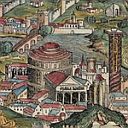0237 Foreign Communities, Collective Identities, and the Arts in Early Modern Rome
Identifiers (Article)
Identifiers (Files)
Abstract
The aim of this RIHA special issue is to locate and define emerging notions and expressions of nationhood in Rome from the 15th through the 17th centuries, and in particular the material, visual, and intellectual practices of nationhood. Primarily the churches built by the nationes with their paintings and sculptures, their music and their ephemeral decorations, their feasts and processions were manifestations of the collective identities of foreign communities, and were understood as such. But nationhood was also expressed through a variety of other individual or institutionalized practices, including embassy, client-patron networks, charity, trade etc.
Statistics


License

This work is licensed under a Creative Commons Attribution-NonCommercial-NoDerivatives 4.0 International License.



